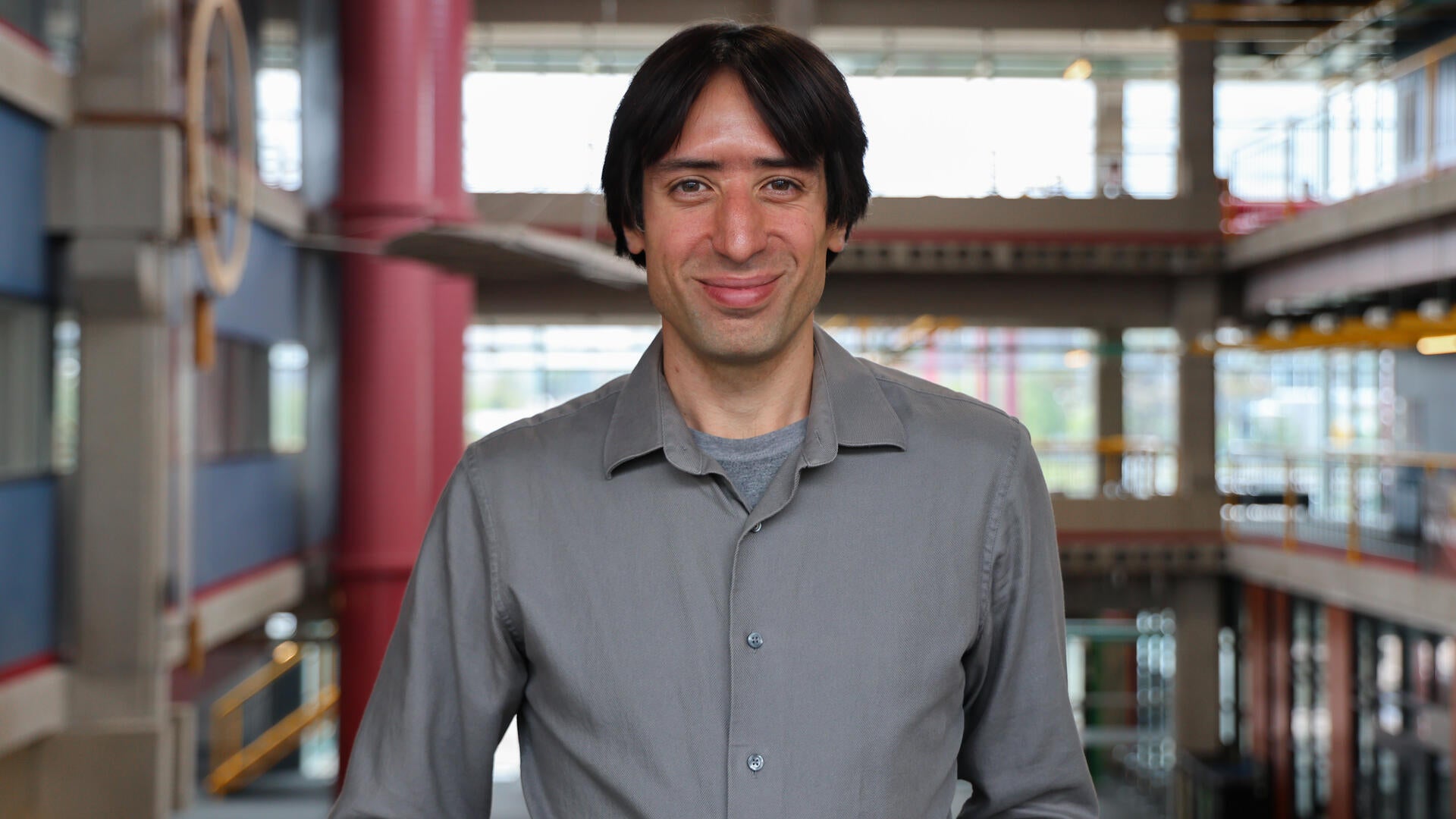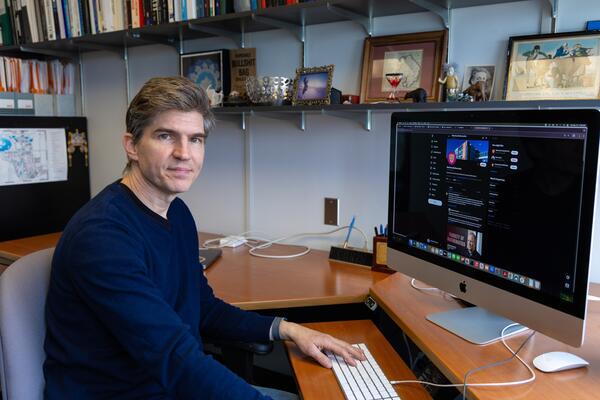
Unexpected connections
Professor Matthew Satriano on the artistry of pure mathematics and the importance of collaborative research

Professor Matthew Satriano on the artistry of pure mathematics and the importance of collaborative research
By Melodie Roschman Faculty of MathematicsWhenever you walk past Dr. Matthew Satriano’s office, it seems like two or three people are inside, scribbling equations on his whiteboard and chatting in animated tones. Even the notice board next to his door reflects this spirit of constant collaboration: it features a caricature portrait of Satriano grinning and gesturing to his next-door neighbor, Matthew Kennedy, whose front door features a matching portrait.

For Satriano, associate professor of pure mathematics, collaboration is at the heart of research. In his eight years at Waterloo, he has partnered with researchers across the hall and around the world on more than fifty articles.
“For me, progress is faster, and I learn a lot more, when I’m talking with other people,” he says. “We frequently come up with ideas that none of us in the group could have generated on our own.”
Those new ideas have earned him two consecutive NSERC Discovery Grants, as well as a current Mathematics Faculty Research Chair. In this interview (edited for clarity and length), Satriano shares some of the problems he’s working on, as well as the journey that led him here.
Both my parents were high school math teachers, so math was always part of my life. In high school, I had some teachers who were fantastic and exposed us to abstract concepts such as vector spaces, but for the most part I didn’t realize that you could do math as a career. I thought I would become an engineer.
Then, shortly before going to university, I went to the Ross Mathematics Summer Program held at the Ohio State University. It was an intense introduction to number theory. We were essentially taught an introductory course through a series of well-crafted problem sets. One of the interesting features of the program is that we did not have access to textbooks or the internet, so we got the experience of discovery on our own and through conversations with others. This experience as well as my introduction to math at university made me decide to study math full time.
The kind of pure math I do today, I think of as an art form. I find it beautiful. I also like the flexibility and the puzzle-solving aspect of it. There are a lot of different ways of getting at the same problem, so you can be creative and try different approaches.
I study algebraic geometry, in a few different flavours. Algebraic geometry is a field of study that uses algebra techniques to solve geometry problems and vice versa. A few of us in Pure Math have research connections with algebraic geometry, including our chair David McKinnon.
The first “flavour” of algebraic geometry I do is “combinatorial”. Combinatorics is the mathematics of enumeration and discrete objects. I’m especially interested in toric varieties, which is a field of study where there is a dictionary between geometry and combinatorial objects. Toric varieties form a nice class of objects because one can write down examples, test conjectures, and gain intuition into algebraic geometry more generally. I have especially enjoyed working on combinatorial algebraic geometry problems with my colleagues in the Department of Combinatorics and Optimization.
The second “flavour” of algebraic geometry I work on is the “arithmetic” flavour. This is an area which at its heart is about finding solutions to equations over the rational number or the integers. These problems can be notoriously difficult, such as Fermat’s Last Theorem. One aspect of my research is working on arithmetic questions using geometric techniques.
There’s a problem that I come back to again and again; some people in the department call it my White Whale. It’s been open since the sixties. My friend Jenna Rajchgot at McMaster and I have created a combinatorial version of the problem, which we have also worked on with Oliver Pechenik in C&O.
Basically, one wants to create two overlapping configurations of blocks in three-dimensional space with a small amount of overlap, but with many similar sub-configurations.
I’m really bad at 3D visualization, so I had to go out and buy a set of wooden blocks to play with. But during the pandemic, I left that set of blocks at my office. Luckily, I have a young son, who let me borrow his colourful letter blocks so that I could keep experimenting.
One thing I really missed during the pandemic was the opportunities for dynamic interactions. A few years ago, during a coffee break at a conference, I chatted with another researcher about an idea I had, and now he’s one of my best collaborators.
I also love working with students at all stages in their careers. The undergrads here are phenomenal. Many of them have amazed me with the progress they were able to make through Undergraduate Student Research Awards and Mathematics Undergraduate Research Awards. Something I like about algebraic geometry is that, although the field has a reputation for being challenging and abstract, there are many aspects of the theory that are accessible to students at all levels.
And then there’s the enormous privilege of being part of a dedicated Faculty of Mathematics with such a diverse set of research expertise. Since I arrived here, I have loved sharing news ideas and learning from my colleagues.
What I really enjoy about this work is that the research often leads you in a direction you couldn’t have predicted ahead of time. I find this is especially true with collaboration. You never know what ideas might be generated from a casual math conversation in the halls.
This profile is the most recent in the Math Marvels series, which highlights the research of faculty members in the Faculty of Mathematics. You can read the first profile in the series, featuring Pure Math chair David McKinnon, here.

Read more
Professor David McKinnon shares his perspective on the beauty, purpose and fun of pure mathematics

Read more
Here are the people and events behind some of this year’s most compelling Waterloo stories

Dr. Chris Bauch, a professor of Applied Mathematics at the University of Waterloo, is part of a team that has developed a new approach to help public health officials predict where outbreaks might occur. (Elisabetta Paiano/University of Waterloo)
Read more
New research demonstrates that vaccine skepticism on social media can predict public health crises
The University of Waterloo acknowledges that much of our work takes place on the traditional territory of the Neutral, Anishinaabeg, and Haudenosaunee peoples. Our main campus is situated on the Haldimand Tract, the land granted to the Six Nations that includes six miles on each side of the Grand River. Our active work toward reconciliation takes place across our campuses through research, learning, teaching, and community building, and is co-ordinated within the Office of Indigenous Relations.